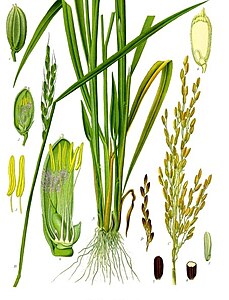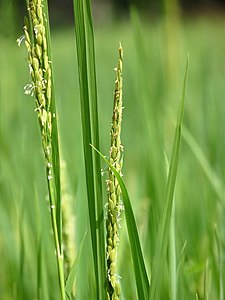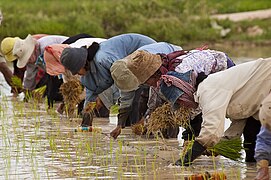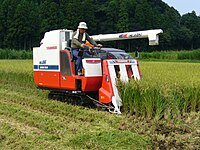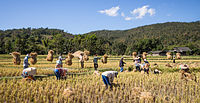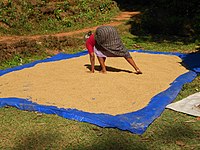
A | B | C | D | E | F | G | H | CH | I | J | K | L | M | N | O | P | Q | R | S | T | U | V | W | X | Y | Z | 0 | 1 | 2 | 3 | 4 | 5 | 6 | 7 | 8 | 9


Rice is a cereal grain and in its domesticated form is the staple food of over half of the world's population, particularly in Asia and Africa. Rice is the seed of the grass species Oryza sativa (Asian rice)—or, much less commonly, O. glaberrima (African rice). Asian rice was domesticated in China some 13,500 to 8,200 years ago; African rice was domesticated in Africa about 3,000 years ago. Rice has become commonplace in many cultures worldwide; in 2021, 787 million tons were produced, placing it fourth after sugarcane, maize, and wheat. Only some 8% of rice is traded internationally. China, India, and Indonesia are the largest consumers of rice. A substantial amount of the rice produced in developing nations is lost after harvest through factors such as poor transport and storage. Rice yields can be reduced by pests including insects, rodents, and birds, as well as by weeds, and by diseases such as rice blast. Traditional rice polycultures such as rice-duck farming, and modern integrated pest management seek to control damage from pests in a sustainable way.
Many varieties of rice have been bred to improve crop quality and productivity. Biotechnology has created Green Revolution rice able to produce high yields when supplied with nitrogen fertiliser and managed intensively. Other products are rice able to express human proteins for medicinal use; flood-tolerant or deepwater rice; and drought-tolerant and salt-tolerant varieties. Rice is used as a model organism in biology.
Dry rice grain is milled to remove the outer layers; depending on how much is removed, products range from brown rice to rice with germ and white rice. Some is parboiled to make it easy to cook. Rice contains no gluten; it provides protein but not all the essential amino acids needed for good health. Rice of different types is eaten around the world. Long-grain rice tends to stay intact on cooking; medium-grain rice is stickier, and is used for sweet dishes, and in Italy for risotto; and sticky short-grain rice is used in Japanese sushi as it keeps its shape when cooked. White rice when cooked contains 29% carbohydrate and 2% protein, with some manganese. Golden rice is a variety produced by genetic engineering to contain vitamin A.
Production of rice is estimated to have caused over 1% of global greenhouse gas emissions in 2022. Rice yields are predicted to fall by some 20% with each 1°C rise in global mean temperature. In human culture, rice plays a role in certain religions and traditions, such as in weddings.
Description
The rice plant can grow to over 1 m (3 ft) tall; if in deep water, it can reach a length of 5 m (16 ft). A single plant may have several leafy stems or tillers. The upright stem is jointed with nodes along its length; a long slender leaf arises from each node.[1] The self-fertile flowers are produced in a panicle, a branched inflorescence which arises from the last internode on the stem. There can be up to 350 spikelets in a panicle, each containing male and female flower parts (anthers and ovule). A fertilised ovule develops into the edible grain or caryopsis.[2]
Rice is a cereal belonging to the family Poaceae. As a tropical crop, it can be grown during the two distinct seasons (dry and wet) of the year provided that sufficient water is made available.[3] It is normally an annual, but in the tropics it can survive as a perennial, producing a ratoon crop.[4]
Agronomy
Growing
Like all crops, rice depends for its growth on both biotic and abiotic environmental factors. The principal biotic factors are crop variety, pests, and plant diseases. Abiotic factors include the soil type, whether lowland or upland, amount of rain or irrigation water, temperature, day length, and intensity of sunlight.[5]
Rice grains can be planted directly into the field where they will grow, or seedlings can be grown in a seedbed and transplanted into the field. Direct seeding needs some 60 to 80 kg of grain per hectare, while transplanting needs less, around 40 kg per hectare, but requires far more labour.[6] Most rice in Asia is transplanted by hand. Mechanical transplanting takes less time but requires a carefully-prepared field and seedlings raised on mats or in trays to fit the machine.[7] Rice does not thrive if continuously submerged.[8] Rice can be grown in different environments, depending upon water availability. The usual arrangement is for lowland fields to be surrounded by bunds and flooded to a depth of a few centimetres until around a week before harvest time; this requires a large amount of water. The "alternate wetting and drying" technique uses less water. One form of this is to flood the field to a depth of 5 cm (2 in), then to let the water level drop to 15 cm (6 in) below surface level, as measured by looking into a perforated field water tube sunk into the soil, and then repeating the cycle.[9] Deepwater rice varieties tolerate flooding to a depth of over 50 centimetres for at least a month.[10] Upland rice is grown without flooding, in hilly or mountainous regions; it is rainfed like wheat or maize.[11]
-
Ploughing a rice terrace with water buffaloes in Java
-
Farmers planting rice by hand in Cambodia
-
Mechanised rice planting in Japan
-
Ancient mountainside rice terraces at Banaue, Philippines
Harvesting
Across Asia, unmilled rice or "paddy" (Indonesian and Malay padi), was traditionally the product of smallholder agriculture, with manual harvesting. Larger farms make use of machines such as combine harvesters to reduce the input of labour.[12] The grain is ready to harvest when the moisture content is 20–25%. Harvesting involves reaping, stacking the cut stalks, threshing to separate the grain, and cleaning by winnowing or screening.[13] The rice grain is dried as soon as possible to bring the moisture content down to a level that is safe from mould fungi. Traditional drying relies on the heat of the sun, with the grain spread out on mats or on pavements.[14]
-
Rice combine harvester in Chiba Prefecture, Japan
-
After the harvest, rice straw is gathered in the traditional way from small paddy fields in Mae Wang, Thailand
-
Drying rice in Peravoor, India
Evolution
Phylogeny
The edible rice species are members of the BOP clade within the grass family, the Poaceae. The rice subfamily, Oryzoideae, is sister to the bamboos, Bambusoideae, and the cereal subfamily Pooideae. The rice genus Oryza is one of eleven in the Oryzeae; it is sister to the Phyllorachideae. The edible rice species O. sativa and O. glaberrima are among some 300 species or subspecies in the genus.[15]
| Poaceae |
| |||||||||||||||||||||||||||||||||||||||||||||||||||||||||
History

Oryza sativa rice was first domesticated in China 9,000 years ago,[16] by people of Neolithic cultures in the Upper and Lower Yangtze, associated with Hmong-Mien-speakers and pre-Austronesians, respectively.[17][18][19][20] The functional allele for nonshattering, the critical indicator of domestication in grains, as well as five other single-nucleotide polymorphisms, is identical in both indica and japonica. This implies a single domestication event for O. sativa.[21] Both indica and japonica forms of Asian rice sprang from a single domestication event in China from the wild rice Oryza rufipogon.[22][21] Despite this evidence, it appears that indica rice arose when japonica arrived in India about 4,500 years ago and hybridised with another rice, whether an undomesticated proto-indica or wild O. nivara.[23]
Rice was introduced early into Sino-Tibetan cultures in northern China by around 6000 to 5600 years ago,[24][25][18] and to the Korean peninsula and Japan by around 5500 to 3200 years ago.[26][27] It was also carried into Taiwan by the Dapenkeng culture by 5500 to 4000 years ago, before spreading southwards via the Austronesian migrations to Island Southeast Asia, Madagascar, and Guam, but did not survive the voyage to the rest of the Pacific.[17][28][29] It reached Austroasiatic and Kra-Dai-speakers in Mainland Southeast Asia and southern China by 5000 years ago.[17][30]
Rice spread around the rest of the world through cultivation, migration and trade, eventually to the Americas as part of the Columbian exchange after 1492.[31] The now less common Oryza glaberrima (African rice) was independently domesticated in Africa around 3,000 years ago,[31] and introduced to the Americas by the Spanish.[32]

